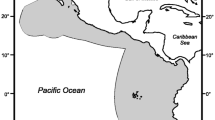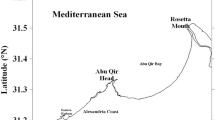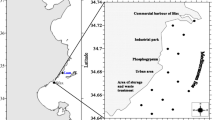Abstract
Trace metals (total mercury, cadmium and zinc) were studied in several tissues of the edible shrimps Pleoticus muelleri and Artemesia longinaris from the Bahía Blanca estuary, Argentina. The digestive gland was shown to be the main organ in which metals accumulate, followed by the stomach-alimentary canal and abdominal muscle.
The metal contents found in the present study largely exceeded those of the same species caught from the Argentine Sea. Mercury concentrations increased proportionally to the total length of the shrimps studied. Only little variation in metal concentrations among individuals seemed to exist.
Finally, the usefulness of these species as bioindicators of trace metal pollution in the Bahía Blanca estuary is discussed.
Similar content being viewed by others
References
Ahsanullah, M., Negilski, D.S., and Mobley, M.C.: 1981, ‘Toxicity of Zinc, Cadmium and Copper to the Shrimp Callianassa australiensis. III Accumulation of Metals’, Mar. Biol. 64, 311–316.
Allard, M. and Stokes, P.M.: 1989, ‘Mercury in Crayfish Species from Thirteen Ontario Lakes in Relation to Water Chemistry and Smallmouth Bass (Micropterus dolomieui) Mercury’, Can. J. Fish. Aq. Sci. 46, 1040–1046.
Anderson, R.V., Vinikour, W.S., and Brower, J.E.: 1978, ‘The Distribution of Cd, Cu, Pb and Zn in the Biota of Two Freshwater Sites with Different Trace Metal Inputs’, Holarctic Ecol. 1, 377–384.
Angelescu, V. and Boschi, E.E.: 1959, ‘Estudio biológico-pesquero del langostino de Mar del Plata, en conexión con la operación Nivel Medio’, Serv. Hidrogr. Nav., Bs.As. H-1017, pp. 1–135.
Bagatto, G. and Alikhan, M.A.: 1987(a), ‘Copper, Cadmium and Nickel Accumulation in Crayfish Populations near Copper-Nickel Smelters at Sudbury, Ontario, Canada’, Bull. Environ. Contam. Toxicol. 38, 540–545.
Bagatto, G. and Alikhan, M.A.: 1987(b), ‘Zinc, Iron, Manganese and Magnesium Accumulation in Crayfish Populations near Copper-Nickel Smelters at Sudbury, Ontario, Canada’, Bull. Environ. Contam. Toxicol. 38, 1076–1081.
Boothe, P.N. and Knauer, G.A.: 1972, ‘The Possible Importance of Fecal Material in the Biological Amplification of Trace and Heavy Metals’, Limnol. Oceanogr. 17 (2), 270–274.
Boschi, E.E.: 1969, ‘Estudio biológico-pesquero del camarón Artemesia longinaris Bate de Mar del Plata’, Bol. Inst. Biol. Mar. 18, 47 pp.
Brown, B.E.: 1982, ‘The Form and Function of Metal-Containing “Granules” in Invertebrates Tissues’, Biol. Rev. 57, 621–667.
Bryan, G.W., Langston, W.J., Hummerstone, L.G., and Burt, G.R.: 1985, ‘A Guide to the Assessment of Heavy Metal Contamination in Estuaries using Biological Indicators’, Mar. Biol. Ass. U.K., Occ. Publ., 4, 92 pp.
Bryan, G.W., Hummerstone, L.G. and Ward, E.: 1986, ‘Zinc Regulation in the Lobster Homarus Gammarus: Importance of Different Pathways of Absorption and Ecretion’, J. Mar. Biol. Ass. U.K. 66, 175–199.
Fischer, H.: 1989, ‘Cadmium in Seawater Recorded by Mussels: Regional Decline Established’, Mar. Ecol. Progr. Ser. 55, 159–169.
Freije, R.J., Asteasuain, R.O., Schmidt, A.S. and Zavatti, J.R.: 1981, ‘Relaciones de la salinidad y temperatura del agua de mar con las condiciones hidrometeorológicas de la porción interna del estuario de Bahía Blanca’, Inst. Arg. Oceanogr., Contrib. Científ. No. 57, 20 pp.
Goldberg, E.D., Bowen, V.T., Farrington, J.W., Harvey, G., Martin, J.H., Parker, P.L., Risebrough, R.W., Robertson, W., Schneider, E., and Gamble, E.: 1978, ‘The Mussel Watch’, Environ. Conserv. 5, 101–125.
Huckabee, J.W., Elwood, J.W., and Hildebrand, S.G.: 1979, ‘Accumulation of Mercury in Freshwater Biota’, in: Nriagu, J.O. (Ed.), The Biogeochemistry of Mercury in the Environment, Elsevier/North Holland Biomedical Press, pp. 277–302.
Marcovecchio, J.E., Moreno, V.J., and Pérez, A.: 1986(a), ‘Biomagnification of Total Mercury in Bahía Blanca Estuary Shark’, Mar. Pollut. Bull. 17 (6), 276–278.
Marcovecchio, J.E., Lara, R.J., and Gómez, E.A.: 1986(b), ‘Total Mercury in Marine Sediments near a Sewage Outfall. Relation with Organic Matter’, Environ. Tech. Lett. 7, 501–507.
Marcovecchio, J.E., Moreno, V.J., and Pérez, A.: 1989(a), ‘Total Mercury Contents in Marine Organisms of the Bahía Blanca Estuary Trophic Web’, in: Seelinger U., Lacerda L.D., and Patchineelam, S.R. (Eds.), Metals in Coastal Environments of Latin America, Springer-Verlag, Heidelberg, pp. 122–129.
Marcovecchio, J.E., Moreno, V.J., and Pérez, A.: 1988(b), ‘Determination of Heavy Metal Concentrations in the Biota of Bahía Blanca, Argentina’, Sci. Tot. Environ. 75, 181–190.
Martin, J.H.: 1970, ‘The Possible Transport of Heavy Metals via Moulted Copepod Exoskeletons’, Limnol. Oceanogr. 15 (5), 756–761.
Menni, R.C.: 1986, ‘Shark Biology in Argentina: A Review’, in: Uyeno, T., Arai, R., Taniuchi, T., and Matsumura, K. (Eds.), Indo-Pacific Fish Biology: Proc. 2nd. Int. Conf. Indo Pacific Fishes, Ichthyolog. Soc. Jap. Tokyo, pp. 425–436.
Olafson, R.W., Kearns, A., and Sim, R.G.: 1979, ‘Heavy Metal Induction of Metallothionein Synthesis in the Hepatopancreas of the Crab Scylla Serrata’, Comp. Biochem. Physiol. 62B, 417–424.
Overnell, J.: 1982, ‘A Method for the Isolation of Metallothionein from the Hepatopancreas of the Crab Cancer pagurus that Minimizes the Effect of the Tissues Proteases’, Comp. Biochem. Physiol. 73B, 547–553.
Pérez, A., Moreno, V.J., Moreno, J.E., and Malaspina, A.: 1986, ‘Distribución de mercurio total en pescados y mariscos del Mar Argentino’, Rev. Invest. Desarr. Pesq. 6, 103–115.
Phillips, D.J.H.: 1976, ‘The Common Mussel Mytilus Edulis as an Indicator of Pollution by Zinc, Cadmium, Lead and Copper. I. Effects of Environmental Variables on Uptake of Metals’, Mar. Biol. 38, 59–69.
Phillips, D.J.H.: 1980, Quantitative Aquatic Biological Indicators, Applied Sci. Publ. Ltd., London, 455 pp.
Popham, J.D., Johnson, D.C., and D'Auria, J.M.: 1980, ‘Mussels (Mytilus edulis) as ‘Point Source’ Indicators of Trace Metal Pollution’, Mar. Pollut. Bull. 11, 261–263.
Romeo, M. and Gnassia-Barelli, M.: 1988, ‘Donax trunculus and Venus verrucosa as Bioindicators of Trace Metal Concentrations in Mauritanian Coastal Waters’, Mar. Biol. 99, 223–227.
Salomons, W. and Förstner, U.: 1984, Metals in the Hydrocycle, Springer-Verlag, Heidelberg, 349 pp.
Stinson, M.D. and Eaton, D.L.: 1983, ‘Concentrations of Lead, Cadmium, Mercury and Copper in the Crayfish (Pacifasticus leniusculus) Obtained from a Lake Receiving Urban Runoff’, Arch. Environ. Contam. Toxicol. 12, 693–700.
Uthe, J.F., Armstrong, F.A.J., and Stainton, M.P.: 1970, ‘Mercury Determination in Fish Samples by Wet Digestion and Flameless Atomic Absorption Spectrophotometry’, J. Fish. Res. Bd. Can. 27 (4), 308–312.
Van Duyn-Henderson, J.A. and Lasenby, D.C.: 1986, ‘Zinc and Cadmium Transport by the Vertical Migrating Opossum Shrimp’, Mysis relicta', Can. J. Fish. Aq. Sci. 43, 1726–1732.
Vermeer, K.: 1972, ‘The Crayfish, Orconectes virilis, as an Indicator of Mercury Contamination’, Can. Fld. Nat. 86, 123–125.
Villa, N. and Pucci, A.E.: 1987, ‘Seasonal and Spatial Distributions of Copper, Cadmium and Zinc in the Seawater of Blanca Bay’, Est. Coast. Shelf Sci. 25, 67–80.
White, S.L. and Rainbow, P.S.: 1986(a), ‘Accumulation of Cadmium by Palaemon Elegans (Crustacea: Decapoda)’, Mar. Ecol. Progr. Ser. 32, 17–25.
White, S.L. and Rainbow, P.S.: 1986(b) ‘A Preliminary Study of Cu-, Cd-, and Zn-Binding Components in the Hepatopancreas of Palaemon elegans (Crustacea: Decapoda)’, Comp. Biochem. Physiol. 83C, 111–116.
White, S.L. and Rainbow, P.S.: 1987, ‘Heavy Metal Concentrations and Size Effects in the Mesopelagic Decapod crustacean Systellapis debilis’, Mar. Ecol. Progr. Ser. 37, 147–151.
Author information
Authors and Affiliations
Rights and permissions
About this article
Cite this article
Marcovecchio, J.E. Trace metal residues in tissues of two crustacean species from the Bahia Blanca Estuary, Argentina. Environ Monit Assess 29, 65–73 (1994). https://doi.org/10.1007/BF00546779
Received:
Revised:
Issue Date:
DOI: https://doi.org/10.1007/BF00546779




